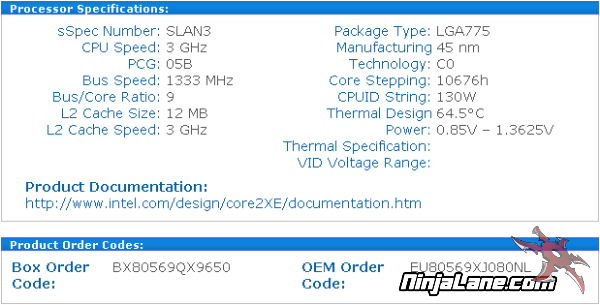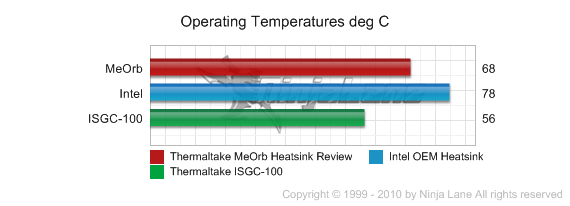After careful consideration I have decided to transfer all hardware review activities to a new domain. I purchased Hardwareasylum.com in 2012 and have been working hard to build a new and improved Ninjalane on that domain. If you are reading this you have reached one of the archived articles, news, projects and/or reviews that were left behind during the site migration.
Please update your bookmarks and be sure to visit the new and improved Ninjalane at Hardwareasylum.com
Thermaltake MeOrb Heatsink Review
Author: Jim Manis
Published: Tuesday, August 18, 2009
Benchmarks
The Thermaltake MeOrb has mounting designed to accomodate the LGA775 and the common AMD sockets, However it is not designed for the new Intel 1366 socket.
The system as it was tested
DFI LanPartyJR P45 T2RS P45 chipset
Core 2 Quad Extreme Edition QX9650 (using 2 cores)
Thermaltake MeOrb cooler
Intel stock heatsink/fan
Thermaltake ISGC-100
During the load tests it was quickly discovered that our CPU was producing more heat that the CPU could handle. The QX9650 is a 130watt CPU as opposed to the 65watt dual core or 90 watt quad core Processors this product was designed for. To combat this and provide repeatable results we use the DFI BIOS to disable two of the processor cores. This brought the heat load down to approximately the same level you would find in a typical 65watt dual core processor. The CPU was also down clocked to 2400mhz to simulate the average CPU Most owners would use with this cooler.
Smart Guardian was used to obtain and record system temperature data and being that this is a quad core processor tuned to dual core settings we need something that will work across only the cores specified. For this task we're using a new version of Prime95 (p95v255a) that will allow you to spawn (n) instances to test with.
In our case we choose 2.
Core 2 Quad Extreme Edition QX9650 (using 2 cores)
Thermaltake MeOrb cooler
Intel stock heatsink/fan
Thermaltake ISGC-100
During the load tests it was quickly discovered that our CPU was producing more heat that the CPU could handle. The QX9650 is a 130watt CPU as opposed to the 65watt dual core or 90 watt quad core Processors this product was designed for. To combat this and provide repeatable results we use the DFI BIOS to disable two of the processor cores. This brought the heat load down to approximately the same level you would find in a typical 65watt dual core processor. The CPU was also down clocked to 2400mhz to simulate the average CPU Most owners would use with this cooler.
Smart Guardian was used to obtain and record system temperature data and being that this is a quad core processor tuned to dual core settings we need something that will work across only the cores specified. For this task we're using a new version of Prime95 (p95v255a) that will allow you to spawn (n) instances to test with.
In our case we choose 2.

Editors note: Even though the Windows XP task manager reported 100% processor usage we could never attain a 100% of the rated heat output as documented by Intel (see below) when using Prime95 as a basis for that heat production. Knowing this we ran the stress test until the maximum temperature was attainted and stabilized.
Other things to consider when judging software induced heat output.
a) Clock throttling by the processor at high temperatures.
b) Normal software isn't designed to produce maximum heat output.
c) Variances of cooling temperature.
d) Variances in CPU load.
e) Inaccuracies in thermal diode readouts.
Of course the list goes on..
Our testing methodology is aimed to provide a real world look into this heatsink given the test system provided.
Other things to consider when judging software induced heat output.
a) Clock throttling by the processor at high temperatures.
b) Normal software isn't designed to produce maximum heat output.
c) Variances of cooling temperature.
d) Variances in CPU load.
e) Inaccuracies in thermal diode readouts.
Of course the list goes on..
Our testing methodology is aimed to provide a real world look into this heatsink given the test system provided.
Default Speed

A C/W rating can quickly be calculated using this formula.
C/W = (CPU temp - Ambient temp)/(Variance(%) * CPU Watts)
Allowed variance for this test = 85%
CPU Watts = 65W
0.79 C/W = (68C - 24C)/(.85(65W))
C/W = (CPU temp - Ambient temp)/(Variance(%) * CPU Watts)
Allowed variance for this test = 85%
CPU Watts = 65W
0.79 C/W = (68C - 24C)/(.85(65W))
Overclocked

For this next test the CPU was overclocked to 3.0GHZ and voltage adjusted to 1.18v. and the test was re-run.
To calculate a new C/W rating for this test we will need to factor in the increased processor wattage. The formula and constants for this are listed below.
ocC/W = dCPU Watts * (ocMhz / dMhz) * (ocVcore / dVcore)2
ocMhz = 3000
dMhz = 2400
ocVcore = 1.18
dVcore = 1.08
The variance still applies for our C/W calculation
Allowed variance for this test = 85%
CPU Watts = 97W
0.60 C/W = (74C - 24C)/(.85(97W))
To calculate a new C/W rating for this test we will need to factor in the increased processor wattage. The formula and constants for this are listed below.
ocC/W = dCPU Watts * (ocMhz / dMhz) * (ocVcore / dVcore)2
ocMhz = 3000
dMhz = 2400
ocVcore = 1.18
dVcore = 1.08
The variance still applies for our C/W calculation
Allowed variance for this test = 85%
CPU Watts = 97W
0.60 C/W = (74C - 24C)/(.85(97W))
Benchmark Conclusion
In our heatsink and waterblock tests we don't really focus on overall load temperatures but rather how well the product can remove heat given a specified heat load. Since this is a real world testing method we need to take into consideration real world variables and estimate tolerances. This is why we normally only apply 85% of the total wattage output to our heat calculations.
The resulting C/W number is used to rate how efficient a heatsink or waterblock is based on the given heat load. These numbers can be used to determine heat capacity, the larger the difference the less efficient the heatsink is. (aka not good for overclocking)
Here we have a heatsink that has gotten more efficient with an increased heat load. All too often we find a rather pronounced variance between the default and overclocked speeds which is sometimes good and sometimes bad. For these tests you'll see that the resulting C/W numbers have actually reversed meaning that we have not even gotten close to the thermal limit of this cooler provided that we are using a dual or quad core processor.
Keep in mind these calculations are provided for demonstration purposes only and may not reflect the actual lab tested C/W rating, but we're pretty close.
The resulting C/W number is used to rate how efficient a heatsink or waterblock is based on the given heat load. These numbers can be used to determine heat capacity, the larger the difference the less efficient the heatsink is. (aka not good for overclocking)
Here we have a heatsink that has gotten more efficient with an increased heat load. All too often we find a rather pronounced variance between the default and overclocked speeds which is sometimes good and sometimes bad. For these tests you'll see that the resulting C/W numbers have actually reversed meaning that we have not even gotten close to the thermal limit of this cooler provided that we are using a dual or quad core processor.
Keep in mind these calculations are provided for demonstration purposes only and may not reflect the actual lab tested C/W rating, but we're pretty close.

